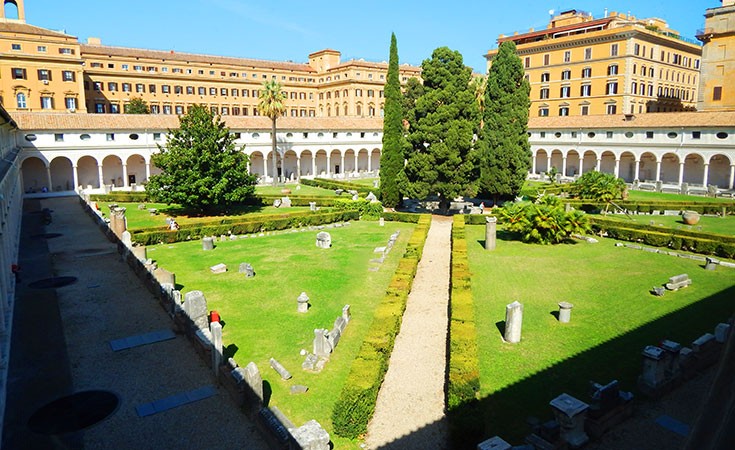
It is a monumental complex most famous for its size and how well preserved it is. The Baths of Diocletian are the largest public baths ever built during the ancient Roman era. Later they were transformed by a famous artist and architect Michelangelo and today they represent cultural heritage and belong to the National Museum of Rome.
Baths were built between 298 and 306 AD and occupied an area of incredible 13 hectares. They were able to host up to 3000 people at the same time. Inside the complex there was a large garden and a central building that was divided into numerous smaller areas: frigidarium (an area with a pool of cold water), tepidarium (the area with a warm water pool), calidarium (with a pool of hot water) and natatio (a 2500 m2 pool). The water for the baths was provided from the Aqueduct Aqua Marcia which was built in the early 2nd century. The Baths of Diocletian were in use till 537 AD and the siege of Rome by Ostrogoths. Vitiges, the king of Ostrogoths, ordered the aqueduct to be destroyed.
In the 16th century it was decided that a church and a monastery should be built. The monastery was composed of a big building, a small building and houses for the monks. This reconstruction was entrusted to Michelangelo. Even though Michelangelo only managed to make the initial design and oversee the initial phases of the construction before his death, the big monastery was named after him. The monastery was seized from the church in 1870, and in 1889 it became the seat of the National Museum of Roman Antiquities. With some 10.000 m2 and 100 unique pillars, this monastery was one of the largest in Italy.
At the beginning, the Church of Santa Maria of Angels and Martyrs (Santa Maria degli Angeli e dei Martiri) was leaning on the ancient walls and had one small chapel dedicated to angels. In the meantime, the monks lobbied for a new monastery and finally Pope Pio IV entrusted the work of rebuilding the chapel to Michelangelo. In 1749, additional work on the basilica was carried out by Luigi Vanvitelli – an Italian painter and architect, when additional entrance was opened towards the former steam baths of the complex.
Nowadays, the following museums are located within the baths:
The Museum of Epigraphs occupies three floors in the monastery of Michelangelo and also the garden where more than a thousand sculptures, mosaics and objects from the daily life of ancient Romans are exhibited. All pieces represent historical collections mostly discovered during the archeological excavations.
The Museum of Prehistory occupies the second floor of the monastery of Michelangelo. The collection is composed of archeological findings from the earliest phases of the ancient culture - the period of the 11th and 12th century BC till the beginning of the 6th century BC. Based on the findings, the social, economical and religious aspects of the society were reconstructed.
Ticket prices for Baths of Diocletian
The ticket is valid 3 days for 4 sites: Palazzo Massimo, Palazzo Altemps, Crypta Balbi, Terme di Diocleziano.
Regular ticket price is: 7 Euros (€).
Reduced ticket price is: 3.5 Euros (€).
Reduced ticket price: for citizens of European Union between 18 and 24.
Free entrance: for individuals younger than 18.
We advise you to check ticket prices before visiting – check the official website of the Baths of Diocletian in Rome.
Working hours of Baths of Diocletian
From Tuesday to Sunday working hours are: 09:00- 19:45h
Museum is closed: on Mondays, January1st, December 25th.
We advise you to check working hours before visiting – check the official website of the Baths of Diocletian in Rome.